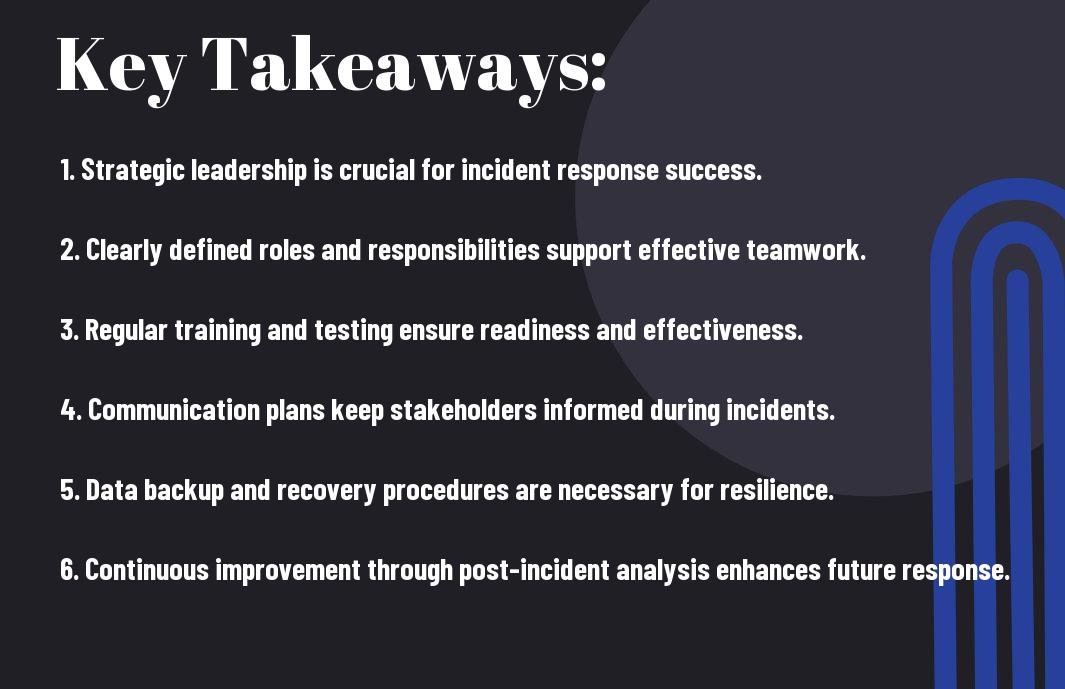There’s no denying the critical importance of having a robust incident response plan in place to protect your organization against cybersecurity threats. In this blog post, I will walk you through the 10 key components vital for crafting an effective incident response plan that will help safeguard your business and minimize potential damages. Let’s dive in and ensure you are well-prepared to handle any security incidents that may come your way.
Key Takeaways:
- Early Detection is Crucial: Implementing a system to quickly detect incidents can significantly reduce the impact on your organization.
- Clear Communication Protocols: Having clear communication channels and designated roles during an incident can streamline response efforts and prevent confusion.
- Regular Testing and Updating: It is necessary to regularly test and update your incident response plan to ensure its effectiveness and readiness in the face of evolving threats.
Establish Clear Roles
Define Incident Response Team
The first step in establishing clear roles in your incident response plan is to define your incident response team. The team should consist of individuals with varying skill sets and expertise, such as IT personnel, security professionals, legal counsel, and communications specialists. Each member should be assigned specific responsibilities and duties in the event of an incident.
Identify Key Stakeholders
One critical component of your incident response plan is to identify key stakeholders. These individuals are not necessarily part of the incident response team but have a vested interest in the outcomes of an incident. They could include senior management, legal teams, PR and communications departments, and regulatory bodies.
With their involvement, you can ensure that all necessary parties are kept informed and that proper procedures are followed to mitigate the impact of an incident. Engaging key stakeholders early in the process will help streamline communication and decision-making when time is of the essence.


Develop Communication Plan
Assuming an incident has occurred, the first step in managing it effectively is to establish a robust communication plan. This plan should outline how you will communicate with internal stakeholders, external partners, customers, and the public during and after the incident. A clear and well-thought-out communication plan can help prevent panic, misinformation, and confusion, ultimately minimizing the impact of the incident on your organization.
Establish Notification Procedures
Assuming an incident has taken place, it is crucial to have clear notification procedures in place. This includes identifying who needs to be notified, how they should be informed, and the escalation path for critical issues. Time is of the essence when responding to an incident, so having predefined notification procedures can ensure a swift and coordinated response.
Identify Communication Channels
Little can be more damaging during an incident than not having the right communication channels identified. Whether it’s email, phone, text messages, or social media, knowing how you will reach your stakeholders is vital. Moreover, you should also consider alternative communication methods in case primary channels are unavailable or compromised. Having multiple communication channels ensures that your messages reach the intended recipients, even in challenging circumstances.
Identify Incident Classification
For a robust incident response plan, it is crucial to identify the classifications of incidents that your organization may face. This step helps in understanding the nature and scope of incidents, allowing for a more targeted and effective response.
Categorize Incident Severity
Some incidents may pose a greater threat to your organization’s operations, data, or reputation than others. By categorizing incident severity, you can prioritize response efforts based on the level of impact a particular incident may have. This classification can help in allocating resources efficiently and deploying them where they are most needed.
Determine Incident Impact
Impact assessment is a key component of incident classification. Determining the incident impact involves evaluating the extent of the harm caused by the incident, including potential financial losses, data breaches, operational disruptions, and reputational damage. Understanding the impact helps in gauging the severity of the incident and tailoring the response actions accordingly.
Incident response plans should include a detailed process for assessing the impact of incidents, taking into account both immediate and long-term consequences. This analysis enables organizations to make informed decisions during incident response and mitigation, minimizing the overall impact on the business.
Develop Incident Containment
After identifying a security incident, the next crucial step in your incident response plan is to develop a strategy to contain the incident effectively. Containment aims to prevent further damage, minimize the impact, and restore normal operations as quickly as possible.
Isolate Affected Systems
Systems that have been compromised or affected by the incident need to be isolated immediately to prevent the spread of the threat to other parts of your network. You must disconnect these systems from the network to contain the incident and avoid further damage. By isolating the affected systems, you can analyze the extent of the compromise and devise a plan to remediate the issue without risking the overall network security.
Implement Temporary Fixes
Some incidents may require immediate action to prevent ongoing damage or data loss. Implementing temporary fixes can help stabilize the situation while you work on a more permanent solution. These fixes could include disabling certain services, blocking malicious IP addresses, or applying patches to vulnerable systems. Remember that temporary fixes are just that – temporary. They should not be seen as a long-term solution but as a necessary step to contain the incident and protect your organization’s assets.
Implement these temporary fixes cautiously and document all actions taken for future reference and analysis. It is imperative to track the changes made during the containment phase to understand their effectiveness and ensure they do not introduce new security risks into your environment.
Conduct Incident Analysis
Your incident response plan should include conducting a thorough incident analysis to understand what happened and why. This analysis is crucial for improving future incident response and preventing similar issues from occurring again. There are two key components to consider in the incident analysis process: identifying root cause analysis and determining incident timeline.
Identify Root Cause Analysis
Assuming you want to prevent similar incidents in the future, identifying the root cause of an incident is crucial. By digging deep and finding the underlying issue that led to the incident, you can implement effective solutions to prevent it from happening again. This may involve conducting interviews, examining system logs, or using other forensic techniques to identify the root cause.
Determine Incident Timeline
Even if the incident seems straightforward at first glance, it is crucial to determine the exact timeline of events that occurred. Understanding when the incident started, how it progressed, and when it was finally resolved can provide valuable insights into how to improve response times and mitigate the impact of future incidents.
Identifying the precise sequence of events can help you pinpoint vulnerabilities in your systems or processes that may have contributed to the incident. This detailed timeline can also be valuable when communicating with stakeholders or conducting post-incident reviews to ensure all aspects of the incident are thoroughly understood.
Develop Incident Eradication
Keep How to Craft an Effective Incident Response Plan handy as you move to the next crucial stage of incident response: eradication. This step focuses on permanently eliminating the root cause of the incident to prevent any further occurrences.
Implement Permanent Fixes
Eradication involves implementing permanent fixes to address the vulnerabilities or weaknesses exploited during the incident. These fixes should not only resolve the current issue but also strengthen your defenses to mitigate similar incidents in the future. It is necessary to prioritize and test these fixes thoroughly before deploying them across your systems.
Verify Solution Effectiveness
You’ll want to ensure that the solutions implemented during the eradication phase are effective and sustainable. This involves thorough testing and validation to confirm that the fixes have successfully addressed the root cause of the incident. Regular monitoring and follow-up are also crucial to verify the long-term effectiveness of the implemented solutions.
Implement Incident Recovery
Once again, when an incident occurs, your incident response plan should outline the steps to take to restore normal operations as efficiently as possible. This is a critical phase in incident response as it aims to minimize the impact of the incident on your organization.
Restore Normal Operations
Little time should be wasted in restoring normal operations after an incident. The longer your systems are down, the more detrimental it can be to your business. Make sure you have documented procedures in place to quickly recover systems and data. Prioritize restoring the most critical systems first to minimize the disruption to your daily operations.
Validate System Functionality
Operations should not resume until you have validated that your systems are functioning properly. This step is crucial to ensure that no vulnerabilities or backdoors created during the incident remain. Testing system functionality can help identify any lingering issues that need to be addressed before fully resuming normal operations.
Implementing a thorough validation process can prevent the reoccurrence of the incident and provide assurance that your systems are secure and stable. It is important to involve key stakeholders in this validation process to gather feedback and insights that can help improve your incident response plan for future incidents.
Conduct Incident Post-Mortem
Despite the stressful nature of an incident, it is crucial to conduct a thorough post-mortem to learn from the experience and improve your incident response plan. This phase is imperative for strengthening your organization’s resilience and preparedness for future incidents.
Document Incident Lessons
Documenting the lessons learned from an incident is a critical step in the post-incident process. By analyzing what occurred, you can identify weaknesses in your response plan and areas for improvement. I recommend creating a detailed report that outlines the incident timeline, the actions taken, the outcomes, and any issues that arose during the response.
Identify Improvement Opportunities
Incident response is an iterative process, and there are always opportunities for improvement in your strategies and procedures. By evaluating the incident response process, you can pinpoint areas that need enhancement, such as communication protocols, escalation procedures, or specific technical controls. It’s imperative to take a proactive approach and continuously refine your incident response plan based on these findings.
With a comprehensive post-incident analysis, you can strengthen your incident response capabilities and enhance your organization’s overall resilience. By documenting incident lessons and identifying improvement opportunities, you are better prepared to handle future incidents effectively and mitigate potential risks to your organization.
Establish Continuous Improvement
Now, it’s crucial to continuously improve your incident response plan to ensure it remains effective in the face of evolving cyber threats. If you haven’t already, I recommend checking out How to Create a Cybersecurity Incident Response Plan for a detailed guide on setting up your initial plan.
Review Incident Response Plan
Any effective incident response plan should undergo regular reviews to identify any gaps or areas for enhancement. Conducting tabletop exercises and simulations can help uncover weaknesses in your plan and provide valuable insights for improvement. Make sure to involve key stakeholders from different departments to ensure comprehensive feedback and perspectives.
Update Plan Regularly
Incident response plans should not be static documents but living resources that evolve with your organization’s changing landscape. Incident trends, new technologies, and regulatory requirements can all impact the effectiveness of your plan. Regularly update your plan to incorporate lessons learned from past incidents and stay ahead of emerging threats. Incident response plans that are not regularly updated run the risk of becoming outdated and ineffective.
Review your incident response plan at least annually, or more frequently if there are significant changes within your organization or the threat landscape. Updating the plan will demonstrate your commitment to cybersecurity readiness and ensure that your organization is well-prepared to respond to any incident effectively. Note, a well-prepared and continuously improving incident response plan is key to mitigating the impact of cyber incidents on your organization.
Final Words
To wrap up, crafting an effective incident response plan requires careful consideration of the 10 key components outlined in this guide. By ensuring that your plan addresses identification, classification, response, recovery, and communication, you can better prepare your organization to handle cybersecurity incidents effectively. Remember to regularly review and update your plan to adapt to evolving threats and technologies.
Ultimately, having a robust incident response plan in place can make all the difference in minimizing the impact of a security breach on your organization. By following these key components and tailoring them to your specific needs, you can better protect your data, systems, and reputation in the face of cyber threats.
FAQ
Q: Why is it important to have an incident response plan?
A: Having an incident response plan is crucial for effectively managing and minimizing the impact of security incidents. It helps to ensure a coordinated and systematic response, reduces the response time, and mitigates potential damages to the organization.
Q: What are the key components of an effective incident response plan?
A: The key components of an effective incident response plan include preparation, identification, containment, eradication, recovery, communication, documentation, training, testing, and continuous improvement. By incorporating these components, organizations can establish a proactive and structured approach to incident response.
Q: How can organizations improve their incident response plan?
A: Organizations can improve their incident response plan by regularly reviewing and updating it to address emerging threats and vulnerabilities. They should also conduct regular training and exercises to ensure that personnel are familiar with their roles and responsibilities during a security incident. Additionally, conducting post-incident reviews and analysis helps identify areas for improvement and enhances the overall effectiveness of the incident response plan.







